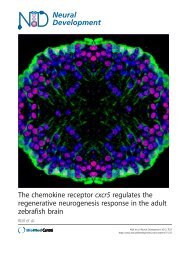Neural Development - BioMed Central
Neural Development - BioMed Central
Neural Development - BioMed Central
You also want an ePaper? Increase the reach of your titles
YUMPU automatically turns print PDFs into web optimized ePapers that Google loves.
<strong>Neural</strong> <strong>Development</strong> 2009, 4:1<br />
http://www.neuraldevelopment.com/content/4/1/1<br />
Effect of NM23-X4 on cell cycle regulation<br />
Figure 8 (see previous page)<br />
Effect of NM23-X4 on cell cycle regulation. (A) BrdU assay in Xenopus retina. The indicated constructs were co-lipofected<br />
with GFP at stage 15. BrdU was injected into embryos from stage 30 to 41 and ratios of BrdU positive cells within GFP<br />
positive lipofected cells in the inner nuclear layer (INL) and ganglion cell layer (GCL) were determined as described in the<br />
Materials and methods. NM23-X4 does not influence proliferation, while shX4-A and -B reduce the ratio of BrdU positive cells.<br />
Co-overexpression of NM23-X4 with p27Xic1 inhibits p27Xic1 mediated cell cycle arrest. (B, C) NM23 can inhibit p27Xic1-<br />
mediated cell cycle arrest in early embryos. After mRNA injection into a two-cell stage blastomere, the blastomere size of the<br />
injected side was compared with the uninjected side at stage 7. The effect was evaluated and the data are presented in the<br />
graph shown in (C). (D) A proposed model for NM23-X4 function in retinal cell fate determination. Both NM23-X4 and<br />
p27Xic1 are expressed in the CMZ. NM23-X4 expression starts first and then overlaps with p27Xic1 expression. p27Xic1<br />
expression gradually increases in the CMZ [13]. Gliogenic activity is also gradually activated in the ciliary marginal zone. NM23-<br />
X4 inhibits the activity of p27Xic1-mediated gliogenesis at the peripheral side of the p27Xic1-expression domain. This results<br />
in proper temporal and spatial regulation of gliogenesis. Single, double and triple asterisks correspond to P 0.05, 0.01, and<br />
0.001, respectively; error bars indicate standard error of the mean.<br />
development. The exact mechanisms are yet to be elucidated<br />
in future work.<br />
NM23-X4-mediated regulation of cell type distribution<br />
versus cell cycle regulation<br />
Distribution of retinal cell types can be influenced by<br />
modulation of cell cycle regulation and cell death in addition<br />
to cell fate determination. Our analysis shows that<br />
endogenous NM23-X4 functions as an activator of the cell<br />
cycle (Figure 8A–C). This is in accordance with the finding<br />
that NM23-X4 binds to the CDK/cyclin domain at the<br />
amino-terminal region of p27Xic1. The binding may be<br />
antagonistic and compete with the binding of other CDK/<br />
cyclin partners, abolishing the formation of a complex. Is<br />
this cell cycle related activity responsible for the regulation<br />
of the ratio of Müller glial cells in the retina? p27Xic1<br />
has been shown to activate Müller gliogenesis along with<br />
its cell cycle inhibitory action. The cell fate determination<br />
activity is separable from the cell cycle regulatory one,<br />
although both activities are mediated by the amino-terminal<br />
region. Our observations regarding binding of NM23-<br />
X4 with the amino-terminal region of p27Xic1 and functional<br />
assays suggest that NM23-X4 also regulates both<br />
the cell fate determination and cell cycle related activity of<br />
p27Xic1. Further analysis is required to exclude the possibility<br />
of direct cell cycle involvement in the change of cell<br />
type distribution.<br />
Diverse roles of CDKIs and NM23s in biological processes<br />
As mentioned, the amino termini of CDKIs regulate both<br />
cell cycle and cell fate determination. Recent papers show<br />
that the carboxyl termini of CDKIs directly bind with regulators<br />
of cytoskeletal proteins. For example, p21Cip1,<br />
p27Kip1, and p57Kip2 directly bind to Rho kinase/<br />
ROCK, RhoA and Stathmin, and LIM kinase, respectively<br />
[18-22], to influence neurite formation and cell migration.<br />
Knockout mice of CDKIs show normal cell division,<br />
suggesting that they are not essential for the fundamental<br />
cell cycle regulation. Furthermore, differentiation factors<br />
are known to induce expression of CDKIs. Taken together,<br />
these observations indicate that the Cip/Kip CDKIs have<br />
three independent functions: cell cycle inhibition, cell fate<br />
determination, and differentiation. It is demonstrated<br />
that, upon induction by secreted differentiation factors,<br />
the primary role of CDKIs lies in their ability to regulate<br />
the process of neuro/gliogenesis by co-coordinating cell<br />
cycle arrest, cell fate determination, and differentiation.<br />
Our results also demonstrate that NM23 members can<br />
work in a CDKI-dependent context and participate in this<br />
regulatory network. NM23-H1 was originally identified as<br />
an inhibitor of cancer metastasis [24]. However, still little<br />
is known about the mechanism of this action. Recently,<br />
some papers showed that the Cip/Kip CDKIs are major<br />
regulators of cancer metastasis [19]. Our observations<br />
overall propose the attractive hypothesis that CDKIs, regulated<br />
by NM23s, may have a major role in controlling<br />
both neural development and cancer metastasis.<br />
Conclusion<br />
We have identified NM23-X4 as a binding partner of<br />
p27Xic1 and showed that its expression in the CMZ overlaps<br />
with that of p27Xic1. Our functional analysis demonstrates<br />
that endogenous NM23-X4 negatively regulates<br />
p27Xic1-mediated gliogenesis and potentiates neurogenesis<br />
through protein-protein interactions. The glia-inhibitory<br />
function of NM23-X4 is likely to require its NDPK or<br />
histidine dependent kinase activity. Our results suggest<br />
that NM23-X4 functions in a temporal and spatial manner<br />
to regulate the process of gliogenesis during sequential<br />
retinal cell fate determination.<br />
Materials and methods<br />
Bacterial two-hybrid screening and plasmid construction<br />
The bacterial two-hybrid screening was performed by BacterioMatch<br />
(Stratagene Texas, USA) using a bait construct,<br />
pBT-Xic1, that has the amino terminus (1-96 amino<br />
acids) of p27Xic1 and the BacterioMatch Xenopus embryo<br />
library (Stratagene). A positive clone including NM23-X4<br />
Page 15 of 18<br />
(page number not for citation purposes)




